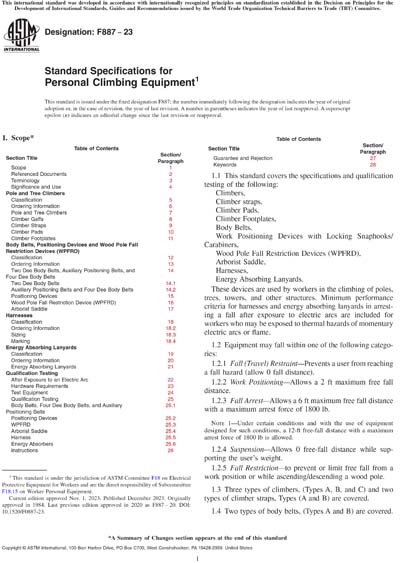Most recent
ASTM F887-23
Standard Specifications for Personal Climbing Equipment
| Table of Contents | |
| Section Title | Section/Paragraph |
| Scope | 1 |
| Referenced Documents | 2 |
| Terminology | 3 |
| Significance and Use | 4 |
| Pole and Tree Climbers |
|
| Classification | 5 |
| Ordering Information | 6 |
| Pole and Tree Climbers | 7 |
| Climber Gaffs | 8 |
| Climber Straps | 9 |
| Climber Pads | 10 |
| Climber Footplates | 11 |
| Body Belts, Positioning Devices and Wood Pole Fall Restriction Devices (WPFRD) |
|
| Classification | 12 |
| Ordering Information | 13 |
| Two Dee Body Belts, Auxiliary Positioning Belts, and Four Dee Body Belts | 14 |
| Two Dee Body Belts | 14.1 |
| Auxiliary Positioning Belts and Four Dee Body Belts | 14.2 |
| Positioning Devices | 15 |
| Wood Pole Fall Restriction Device (WPFRD) | 16 |
| Arborist Saddle | 17 |
| Harnesses |
|
| Classification | 18 |
| Ordering Information | 18.2 |
| Sizing | 18.3 |
| Marking | 18.4 |
| Energy Absorbing Lanyards |
|
| Classification | 19 |
| Ordering Information | 20 |
| Energy Absorbing Lanyards | 21 |
| Qualification Testing |
|
| After Exposure to an Electric Arc | 22 |
| Hardware Requirements | 23 |
| Test Equipment | 24 |
| Qualification Testing | 25 |
| Body Belts, Four Dee Body Belts, and Auxiliary Positioning Belts | 25.1 |
| Positioning Devices | 25.2 |
| WPFRD | 25.3 |
| Arborist Saddle | 25.4 |
| Harness | 25.5 |
| Energy Absorbers | 25.6 |
| Instructions | 26 |
| Guarantee and Rejection | 27 |
| Keywords | 28 |
1.1 This standard covers the specifications and qualification testing of the following:
Climbers,
Climber straps,
Climber Pads,
Climber Footplates,
Body Belts,
Work Positioning Devices with Locking Snaphooks/Carabiners,
Wood Pole Fall Restriction Devices (WPFRD),
Arborist Saddle,
Harnesses,
Energy Absorbing Lanyards.
These devices are used by workers in the climbing of poles, trees, towers, and other structures. Minimum performance criteria for harnesses and energy absorbing lanyards in arresting a fall after exposure to electric arcs are included for workers who may be exposed to thermal hazards of momentary electric arcs or flame.
1.2 Equipment may fall within one of the following categories:
1.2.1 Fall (Travel) Restraint—Prevents a user from reaching a fall hazard (allow 0 fall distance).
1.2.2 Work Positioning—Allows a 2 ft maximum free fall distance.
1.2.3 Fall Arrest—Allows a 6 ft maximum free fall distance with a maximum arrest force of 1800 lb.
Note 1: Under certain conditions and with the use of equipment designed for such conditions, a 12-ft free-fall distance with a maximum arrest force of 1800 lb is allowed.
1.2.4 Suspension—Allows 0 free-fall distance while supporting the user’s weight.
1.2.5 Fall Restriction—to prevent or limit free fall from a work position or while ascending/descending a wood pole.
1.3 Three types of climbers, (Types A, B, and C) and two types of climber straps, Types (A and B) are covered.
1.4 Two types of body belts, (Types A and B) are covered.
1.5 Eight types of work positioning devices: three positioning straps, (Types A, B, and C), three adjustable-positioning lanyards, (Types A, B and C) and two nonadjustable positioning lanyards, (Types A and B) are covered.
1.6 Two types of WPFRD, (Types A and AB) are covered.
1.7 Arborist saddle, (Type A) Work Positioning and Suspension are covered.
1.8 Two types of harnesses, (Types A and B) are covered.
1.9 Two types of energy absorbing lanyards, (Types A and B) are covered.
1.10 The values stated in United States customary units are to be regarded as standard. The values given in parentheses are mathematical conversions to SI units that are provided for information only and are not considered standard.
1.11 The following safety hazards caveat pertains only to the test method portions, 9.2, 10.3, 11.2, 14.1.4, 15.3, 15.4, 16.2, 17.2, 18.4, 21.2, 22, 23, and 25 of this standard: This standard does not purport to address all of the safety concerns, if any, associated with its use. It is the responsibility of the user of this standard to establish appropriate safety, health, and environmental practices and determine the applicability of regulatory limitations prior to use.
1.12 This international standard was developed in accordance with internationally recognized principles on standardization established in the Decision on Principles for the Development of International Standards, Guides and Recommendations issued by the World Trade Organization Technical Barriers to Trade (TBT) Committee.
Content Provider
ASTM International [astm]






